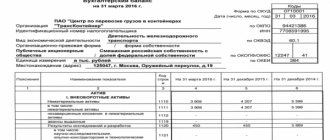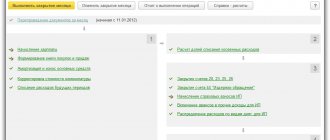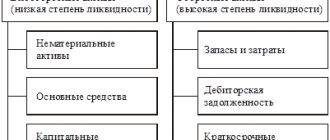In all types of financial statements, there are a number of indicators that ultimately must correspond to each other. What does it mean to conform? This means that they must be equal to each other or there has been interconnection of the financial statements indicators. Such ratios of indicators are not regulated by any legislative documents; they were developed exclusively in accounting practice. In this article we will tell you what the interconnection of financial reporting indicators is and look at the table of indicators.
Interrelation of financial reporting indicators
Monitoring reporting indicators through interconnection is a huge plus for an organization’s accountant, as it allows you to verify the correctness of all reports, as well as quickly eliminate possible errors. Each company determines exactly how to check the indicators independently.
However, it must be taken into account that even if companies use their own or modified reporting forms, the interconnection must be observed in any case, and the principles for constructing reporting must be the same. Indicators of the balance sheet and income statement are disclosed in detail in the statement of changes in capital, statement of cash flows, annex to the balance sheet and explanatory note.
Let's look at the financial statements that are used for interconnection: (click to expand)
- balance sheet (form N1);
- profit and loss statement (form N2);
- statement of changes in capital (form N3);
- cash flow statement (form N4);
- applications to the balance sheet (form N5);
- explanatory notes.
The reliability of financial reporting information is determined by the rules for their preparation, in accordance with current legislation. Reporting must be drawn up in such a way that the so-called user of the reporting has a complete understanding in the future. For example, interim dividends that are paid in the current year are reflected in the “Capital and reserves” section of the balance sheet.
An example of filling out a simplified balance sheet for a simplified tax system
- Information about cash and cash equivalents, which must be reflected in line 4, is collected from all “cash” accounts (50, 51, 52, 55, 57) excluding subaccount 55 “Deposit accounts”.
- The line “Financial and other current assets” contains information about short-term financial investments (account 58), the amount of short-term debts reflected in the settlement accounts, as well as all other assets of the company that do not find a place in this section of the report.
NOTE! Financial investments, accounts receivable and inventories in the balance sheet assets must be shown without taking into account reserved amounts (account balances 59, 63, 14), that is, in a net valuation (PBU 4/99). The main reasons for the discrepancies in the indicators: The organization accepted the founder’s goods for free. This profit is not included in tax income, however, there is no exception for this in the accounting part of the report. The company received dividends. In tax accounting, profit appears at the time they are credited to the account, and in accounting - during the period making a decision on their enrollment, the Organization carried out a revaluation of property in the tax accounting there is no need to display this When carrying out construction work, the start date and completion date fall on different reporting quarters With a declaration on the simplified tax system Organizations that apply a simplified taxation system, in addition to the declaration, submit a report from accounting department Inspectors who compare accounting and tax reporting data are interested in certain indicators - the amounts of income must match.
Table of interrelations of indicators
Monitoring the indicators of all forms of accounting reports is not only the final stage of reporting. Control is also necessary to obtain additional information necessary for analysis. Let's consider the main ratios of financial reporting indicators for 2020.
Balance Sheet and Cash Flow Statement:
| Accounting balance | Cash flow report |
| line 1250 as of December 31, 2017 | = line 4500 for reporting year 2020 |
| line 1250 as of December 31, 2016 | = line 4450 for reporting year 2020 |
| line 1250 as of 12/31/2017 – column as of 12/31/2016 | = line 4400 for reporting year 2020 |
- where, line 1250 – cash.
- line 4400 – cash flow balance.
- line 4450 – cash balance at the beginning.
- line 4500 – balance of funds at the end.
Balance sheet and statement of changes in equity:
| Accounting balance | Statement of changes in equity |
| p.1310 | =p.3100 |
| line 1300 as of December 31, 2017 | = “Total” p.3300 |
| line 1300 as of 12/31/2017 – column as of 12/31/2016 | = p.3310 – “Total” p.3320 |
- where, line 1310 – authorized capital.
- p.1300 – the result of the 3rd section “Capital and reserves”.
- line 3100 – authorized capital.
- line 3300 – amount of capital.
- line 3310 – total increase in capital (previous year).
- line 3320 – total increase in capital (report year).
Statement of financial results and Statement of changes in equity:
| Financial results report | Statement of changes in equity |
| line 2400 for 2020 | = “Total” p. 3311 – “Total” 3321 |
| line 2400 for 2020 | = “Total” p.3211 – “Total” 3221 |
- where, line 2400 – net profit (loss).
- line 3311 – increase in net profit (previous year).
- line 3321 – reduction of capital due to loss (previous year).
- line 3211 – increase in net profit (previous year).
- line 3221 – reduction of capital due to loss (reporting year).
Balance sheet and income statement:
| Accounting balance | Income statement |
| line 1370 as of 12/31/2016 – column as of 12/31/2015 | = page 2500 for 2020 |
- where, line 1370 – retained earnings.
- line 2500 – net profit.
Thus, by checking the control ratios of accounting indicators using the table, companies and individual entrepreneurs will be able to submit reports to the tax authorities without any problems.
Forms in which it is possible to create a balance sheet
To be presented as official reporting, the balance sheet has a specific form. For the internal needs of an organization, it can have many modifications depending on the purpose and the type of data for its compilation:
- data can be taken either on specific dates (balance sheet) or by turnover for a period (turnover balance);
- the source data can be either only accounting, or only inventory, or accounting that is confirmed by inventory results;
- data can be taken into account either with the inclusion of regulatory items (depreciation, reserves, markup) or without them;
- the balance sheet can be drawn up in relation to only one of the types of activities of the enterprise;
- the balance sheet can have either a full or an abbreviated (simplified) form;
- the balance sheet can be drawn up in the form of equality between assets and the sum of capital and liabilities, or it can take the form of equality between capital and the difference between assets and liabilities;
- the balance sheet can be made for one organization or include data for several enterprises (consolidated and consolidated balance sheets);
- in relation to the event, there may be opening, liquidation, separation, and unification balance sheets;
- the balance can be preliminary, forecast, interim, final.
And this is not a complete list of possible options for drawing up a balance sheet for an organization to solve its internal problems. However, the fundamental approaches to filling out this form remain the same regardless of the way the source data is reflected in it.
New balance sheet and other reporting forms
Since 2020, the Federal Tax Service of Russia is obliged to create and maintain a state information resource for accounting (financial) reporting. Therefore, organizations were relieved of the obligation to submit a legal copy of their financial statements for 2020 and beyond to the statistical authorities. You only need to report to the Federal Tax Service at your place of registration. It was established that:
- small businesses submit reports on paper or in the form of an electronic document;
- all other economic entities submit reports in the form of an electronic document.
That is why the forms have been brought into compliance with the new requirements. The most changes were made to Form No. 2 “Report on Financial Results”, in particular, it changed:
- Name,
- line numbers,
- composition of the indicator “Income tax”.
Current forms of accounting (financial) statements are posted on the websites of the Federal Tax Service of Russia and JSC GNIVC. They should be applied starting with reporting for the current year.
Why do we need interconnection of indicators?
Indicator monitoring is needed in order to control the accuracy and completeness of report data before they are submitted to the tax authorities. There are no clear rules for conducting such an independent check. Enterprises do this on their own. It is also interesting that tax authorities also conduct similar audits. When they discover inconsistencies, they demand explanations.
In some cases, such errors can lead to a desk audit or even an on-site audit. Therefore, it is very important to establish the rule of interconnection in your enterprise in order to save yourself from unnecessary problems in the future.
Online magazine for accountants
In our consultation you will find a table of interrelations of financial reporting indicators. It will help you successfully close the reporting campaign for 2017.
Subscribe to the accounting channel in Yandex-Zen!
- 1 Features of interconnection of financial reporting indicators
- 2 Balance sheet and cash flow statement
- 3 Balance sheet and changes in capital
- 4 Financial results and changes in equity
- 5 Relationship with tax reporting
- 6 Specifics of small enterprises
Peculiarities of interconnection of financial reporting indicators There are a number of key financial reporting indicators, the values of which must correspond to each other. That is, they are equal. And only in this case can we say that there has been an interconnection of the indicators of the financial reporting forms.
How to use interconnection in accounting
Reporting forms, both financial and accounting, in addition to the informational relationship, also have a logical relationship. This relationship is visible when one understands the balance sheet results, because for the most important total values, a detailed explanation can be seen in other forms. When deciphering the results in detail, the arithmetic side of filling out the reports is checked, and any changes are clearly visible.
Balance of indicators is the main principle of not only accounting, but also financial reporting.
For small companies and large holdings, accounting indicators are a stimulant for moving forward. It is possible to assess the state in which the company is currently located with the help of accounting records. At the same time, it should be understood that each form of reporting can characterize the situation “in its own way.” By applying relationships in practice, you can study accounting in more depth and draw the necessary conclusions.
The logical connection of the indicators is that they complement each other and also correspond in different reporting forms. Explanations of some balance sheet items can only be found in the accompanying forms. An example is the article “Intangible assets”, the explanation of which can be found in the appendix to the balance sheet.
Similar chapters from other works:
1.1 Environmental statistics: essence, objectives and relationship with other branches of statistics
Growing attention to environmental problems has generated a demand for statistical data characterizing the state of the natural environment and the impact of human society on it. Statistics…
1.1.1 RELATIONSHIP OF SOLVENT CAPACITY AND LIQUIDITY OF THE ENTERPRISE AND BALANCE SHEET
Solvency depends largely on the degree of liquidity of the balance sheet and the enterprise, which characterizes both the current state of settlements and the future. An enterprise may be solvent at the reporting date...
2.2 Interrelation of elements of financial statements
Individual indicators of financial statements are in a certain arithmetic relationship with each other, determined by the logic of constructing reporting forms...
Chapter 1. The role of the balance sheet in the reporting system
Chapter 6. Relationship between the balance sheet and other forms of reporting
The reporting forms of accounting (financial) reporting are characterized by a logical and informational relationship. The essence of the logical connection is the mutual complementation of the reporting forms, their sections and articles...
The role and significance of the balance sheet in financial reporting
1.3 The role of the balance sheet in the financial reporting system
In an organization, the main form of accounting financial reporting is the balance sheet. The role of other forms of accounting reporting is to decipher the data contained in the balance sheet...
1.3 The structure of the balance sheet and the technique of its preparation. The relationship of its sections and articles
The balance sheet in its generally accepted form has the form of a two-sided table, the left side is the asset of the balance sheet, the right side is the liability of the balance sheet. The balance sheet asset reflects the composition and placement of economic assets...
1.4. Relationship between accounting and other sciences
Accounting is an integral part of management and is a complex system of reflection and knowledge of various economic processes and phenomena of economic life...
1.1 The concept of “costs” and its relationship with other categories
The main concepts for characterizing and measuring the costs of an enterprise in the management accounting system are costs, expenses, production and distribution costs...
Relationship between accounting and other sciences
The general theoretical basis for knowledge of the accounting objects taken into account is economic theory, which studies the economic laws of production and distribution of material goods in society...
1.4 Relationship between main reporting forms
financial result accounting reporting The relationship between these reporting forms can be presented in the form of a table; numerical icons allow you to give brief comments on the relationships reflected on it (Appendix 3). 1) income and expenses of the organization...
Interrelation of financial reporting indicators using the example of JSC
Form No. 5. Composition, calculation method, relationship with other forms of reporting
Appendix to the Balance Sheet (Form No. 5) International Financial Reporting Standard “Presentation of Financial Statements” IFRS 1 recommends, along with the main forms, to include…
2.2 The meaning of the balance sheet and individual reporting forms
The main form of financial reporting is the balance sheet. Appendix 1. A visual representation of the financial position is given by all columns and rows as of a certain period...
buh.bobrodobro.ru
Where do discrepancies in income tax and VAT returns come from?
If there are no errors in the submitted information, then why do discrepancies arise? Usually due to different accounting rules for different taxes.
Ideally, the taxpayer’s reporting should comply with the following equality:
However, in practice it is observed extremely rarely. After all, if an organization, for example, received dividends during the year, then for profit tax purposes they had to be taken into account (clause 1 of Article 250 of the Tax Code of the Russian Federation), but did not need to be included in the VAT base. The following are taken into account in the same way:
- income in the form of exchange rate and amount differences (clause 2 of Article 250 of the Tax Code of the Russian Federation);
- surpluses identified during the inventory (clause 20 of article 250 of the Tax Code of the Russian Federation);
- write-off of accounts payable after the expiration of the limitation period (clause 18 of Article 250 of the Tax Code of the Russian Federation), etc.
At the same time, for example, the gratuitous transfer of goods (work, services) is subject to VAT, but does not generate income for profit tax purposes (clause 1, clause 1, article 146, clause 2, article 154 of the Tax Code of the Russian Federation).
In other words, discrepancies in revenue figures in accordance with income tax and VAT returns can be fully explained by accounting requirements. And the task of the organization is to correctly present all this in explanations.








